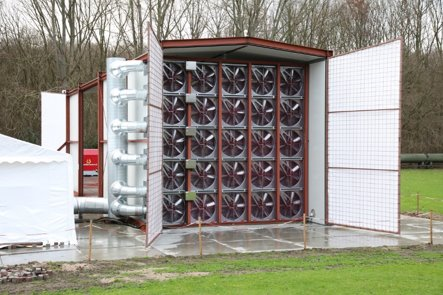
The TNO CBRN Protection conducted a series of experiments in which EU-SENSE sensor nodes were exposed to a variety of concentrations of a phosphorus-containing CWA simulant under ambient conditions.
TNO used their so-called “Breeze Tunnel” facility for these experiments. It consists of a large warehouse-type hall, open to the environment at both ends and with a battery of industrial fans generating a moderate airflow (0-5 m/s, a “breeze” in meteorological terms). The facility is equipped with vapour-generating devices that continuously inject a precisely measured volume of a test substance vapour into the airflow, thus enabling a constant and reproducible substance concentration inside the tunnel. The vapour generating equipment is flexible enough to allow a variety of concentration-time profiles to be generated: constant, spikes, broad or narrow peaks, etc.
For the EU-SENSE experiments, three sensor nodes were placed inside the tunnel, either next to each other or behind each other, while in the latter case, one node was placed outside the breeze tunnel to serve as a chemical background monitor. The sensor nodes each contained five different chemical sensing technologies: Ion mobility spectroscopy (IMS water chemistry and IMS ammonia chemistry), Photoionization detection (PID), Electrochemical cell (EC), Flame-photometric detection (FPD) and Metal oxide sensors (MOS). The primary output signals were collected by the EU-SENSE nodes (designed and manufactured by the ITTI), stored onto an SD card which was periodically read out and the collected data distributed for data analysis and data fusion by the EU-SENSE partner tms.
This experimental setup allowed the TNO to perform such sensor exposures in a controlled manner while still taking the influence of the outside environment into account, including an unplanned but very welcome potential interference by pyrotechnic combustion products from tests elsewhere on the premises. Also, a series of experiments was conducted using a double exposure, in which the CWA simulant was generated over a low background of ammonia generated simultaneously.
A number of data sets were generated from the exposure experiments, as well as large chemical background data sets obtained by letting the nodes collect data during the weekends and overnight. A special data set was also provided to validate the EU-SENSE sensor node network’s ability to quantify a chemical exposure.
The TNO team also collected a variety of information on the performance of the data collection nodes and the individual sensors under the test conditions, which enables further optimization and finetuning of the EU-SENSE configurations. These are exciting results and it will be very interesting to see the outcome of the subsequent data analysis and data fusion!

